
| From Wyoming Tales and Trails This page: Midwest, Western Interior Seaway, Oil Formation, Anticlines and Traps. |
 |

| From Wyoming Tales and Trails This page: Midwest, Western Interior Seaway, Oil Formation, Anticlines and Traps. |
 |
|
|
|
About This Site |
|
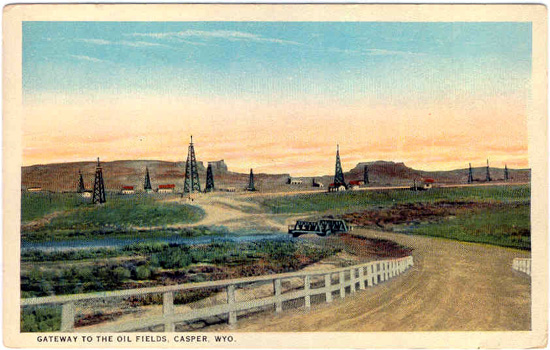 Gateway to Salt Creek Oil Fields, 1920's
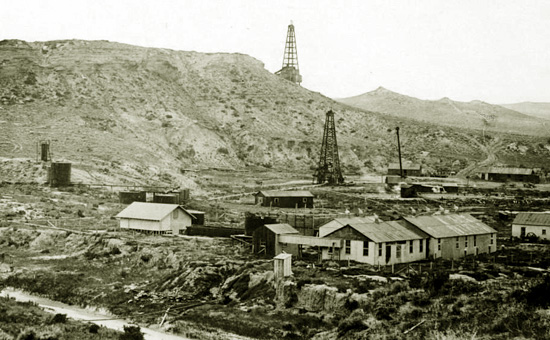 Salt Creek Oil Field, 1922.
In traveling up the Popo Azia a tributary of Wind River we came to an oil springe neare the main Stream whose surface was completely covered over with oil resembling Brittish oil and not far from the same place ware stacks Petrolium of considerable bulkBy 1842, the Hilliard Oil Spring was producing petroleum used in the making of leather, and by 1868 William Carter of Fort Bridger was drilling for oil, although, Mike Murphy is generally credited for the first commerical oil well in the Territory, about 1883. The Salt Creek field was discovered in 1887 by Cyrus William "Cy" Iba (1831-1907). Iba, born in Reinholds, Lancaster County, Pennsylvania, was one who moved west from Indiana in 1851 seeking fortune in the gold fields of California. With the end of the California Gold Rush, Iba moved on to prospecting along the Snake River in Idaho. He ultimately moved into Wyoming. Allegedly, he recalled from his trek to California the oil seeps along the Emigrants's Road near Poison Spider Creek. Thus, in 1883 he began exploring for oil, ultimately finding the Salt Creek field as a result of an oil seep at Jackass Springs. The springs were described by Harold D. Roberts in his 1956 Salt Creek Wyoming: The Story of a Great Oil Field as "an alkali water spring in the side of an arroyo leading into the west bank of Salt Creek, so contaminated with crude oil that as much as a bucketful at a time could be skimmed off of the surface of the little pool which trappers or cowboys had dug for the spring." Laramie City lawyer, surveyor, and former territorial delegate Stephen Downey is also credited with discovery of Jackass Springs. Downey's claim was either abandoned to, or "jumped" by, a group led by Lutheran minister, former "honorary" Nebraska state geologist and former territorial geologist Samuel H. Aughey (1831-1912) and railroad, mining and canal promotor John R. Bothwell. Aughey left Nebraska under a cloud of accusations of forged endorsements. He was later cleared. Aughey is now remembered primarily for his claim that plowing the land would result in increased rainfall. Aughey gave the springs their name. Bothwell, himself, had a somewhat tarnished past. He was cashiered from the Army in 1870 for misappropriation of government funds and property. He moved to New York where he engaged in mining promotion. He left New York under allegations that he had misappropriated shareholders' moneys from a number of mining companies.
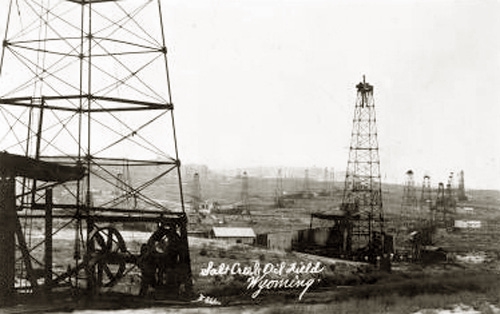 Salt Creek Oil Fields, 1930's
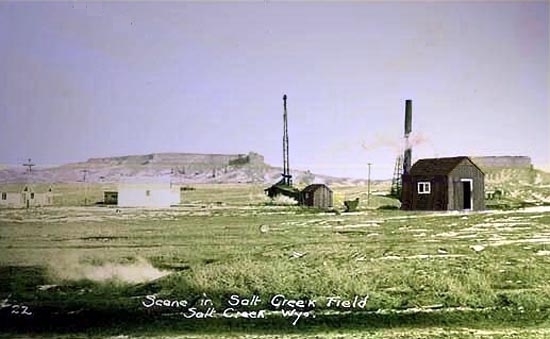 Salt Creek Field, approx. 1930 Other oil strikes in the Wyoming followed the Jackass Springs discovery, including a large find by Philip Martin "Mark" Shannon in Salt Creek in 1889 and finds at Lance Creek north of Lusk, and Oregon Basin in Park County in 1912.
Shannon was originally from Shannondale, Pennsylvania. In Pennsylvania he was a major independent oil producer having an interest at the time in over 20,000 acres of oil leases. Shannon, lying about his age, enlisted in the Union Army at the age of 14. Following the war, he worked for a time as a traveling salesman and then as a wildcat oil driller. His reputation was assured when he hit oil near Cherry Grove, Pennsylvania, in 1882, almost being killed in the process. Shannon's two partners in the venture dispaired of the well when no oil had been hit by 1800 feet in depth and departed the site. Shannon and a contractor, a Captain Haight, continued on. John J. McLaurin in his 1896 Sketches in Crude Oil described the scene:
Shannon stayed to urge the drill a trifle farther and it struck the sand the sand at one o'clock next day. He drove in two pine-plugs, sent a messenger for his partners and filled the well with water to shut in the oil. The well wouldn't consent to be plugged and drowned. The stream broke loose at three o'clock, hurling the tools and plugs into the Forest ozone. Shannon and Haight, standing in the derrick, narrowly escaped death as the tools crashed through roof and fell to the floor.With his discovery of oil at Salt Creek, Shannon began the wholesale filing of claims, ultimately filing on over 150,000 acres in Wyoning. To take advantage of the oil, in 1894 Shannon organized the Pennsylvania Oil and Gas Co. which constructed a small refinery in Casper. There was, however, a difficulty, the refinery only produced 100 barrels a day. The oil had to be hauled in barrels fron the wells by mule-drawn freighters to Casper. Taking equipment for drilling the wells was an adventure. In 1918, Karl T. Schulyer noted in testimony befoe the House of Representatives Committee on the Public Lands that it took three days for the wagons to go from Casper to the Salt Creek Fields. In that age, he testified, even a man on horseback "would find it a mighty hard ride to get there riding from morning until late at night. They usually made two days of it and stopped at the Horse Ranch midway." Horse Ranch was a way station half way between Casper and the oil Fields. Schuyler continued, "The road was very rough and the going was difficult. Water was scarce, weather conditions terrible, snows and blizzards, and it was over this territory and under such conditions that there was transported to this field the material and supplies requisite to develop and carry on the operations there, including the establishment of camps and buildings and other facilities for the work that had to be done"
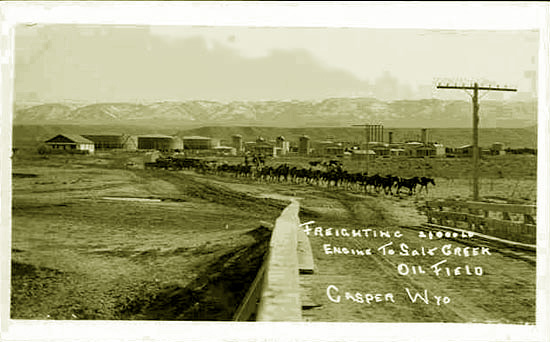 Freighting Equipment to Salt Creek Note sheep wagon at end of train. John D. Rockefeller's Standard Trust looked at Salt Creek, but determined that without a pipeline, the area would not be profitable.
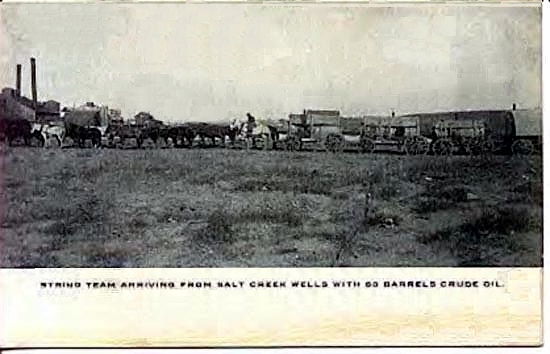 Freight Train hauling 60 barrels of oil to refinery in Casper
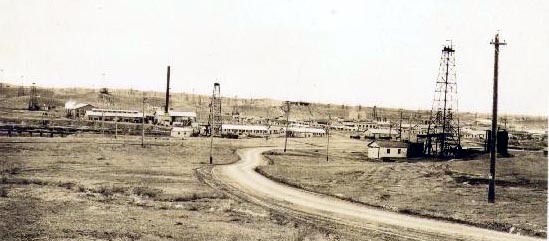 Dutch Camp, approx. 1930.
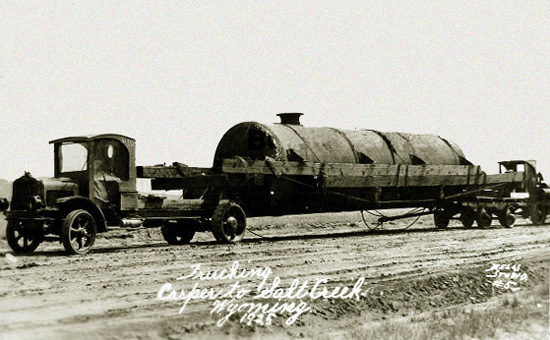 Salt Creek oil transport, approx. 1922.
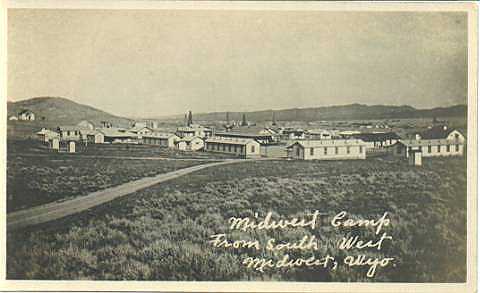 Midwest, Wyo., 1920's The Town of Midwest, Wyoming, was originally named "Shannon Camp" after Shannon. Later it was called the "Home Camp" and was a company-owned town in which the company owned everything, the houses, the club house, the hospital, dormatories for single workers, and the houses rented to families. Midwest Oil Company was acquired by Standard of Indiana in 1921, which in turn is now a part of Amoco-BP.
|